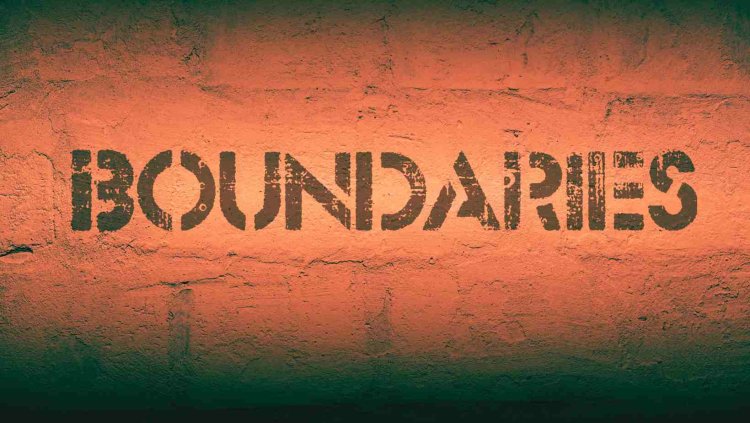Setting Boundaries: The Art of Discipline and Freedom
Unlock the secrets of personal growth with "Setting Boundaries: The Art of Discipline and Freedom." Learn how to navigate life's challenges while maintaining balance and self-control. Discover the power of setting boundaries for a more fulfilling and liberated existence.

Introduction
We often hear people talk about setting boundaries and maintaining discipline in our lives. At the same time, many of us also value freedom - the ability to choose what we want and live according to our own terms. On the surface, these concepts of boundaries, discipline and freedom may seem contradictory. How can we be disciplined and set limits while also feeling free?
In this post, I will explain how setting effective boundaries is actually the key to achieving both discipline and freedom in our lives. By establishing clear limits on what we will and won't accept from others as well as ourselves, we gain control over our choices and behaviors. This in turn leads to a greater sense of empowerment and autonomy. Rather than restricting us, boundaries paradoxically enable freedom by creating structure and clarity in our relationships and responsibilities.
I will discuss how to go about setting boundaries in different life domains such as work, family relationships and friendships. I will also explore some common boundary-setting challenges people face and provide strategies to overcome them. By the end, I hope to convince you that boundaries done right are not about restricting freedom but fostering it. Let's begin our discussion on this important life skill.
Understanding Boundaries
Before getting into the specifics of boundary-setting, it's important to understand exactly what boundaries are. In simple terms, boundaries are limits or lines that define where you end and another person or entity begins. They denote what behavior you are comfortable with and what you are not.
Boundaries differ from person to person based on individual preferences, personality traits as well as cultural and family influences. Some common examples of boundaries include:
- Physical boundaries: Appropriate or inappropriate touching.
- Emotional boundaries: The degree of self-disclosure and intimacy in relationships.
- Time boundaries: Saying no to requests that infringe on your personal or family time.
- Financial boundaries: Not loaning or borrowing money from friends and family.
- Communication boundaries: Responding only during work/school hours to work/school calls and messages.
A key thing about boundaries is that they are meant to protect both you as well as the other person. Healthy boundaries respect each person's needs, preferences and limitations. They create a safe emotional and psychological space for everyone involved.
Why Boundaries are Important
Establishing clear personal boundaries is crucial for several reasons:
- Mental well-being: Strong boundaries shield you from undue emotional stress, anxiety and even trauma by not taking on others' problems and responsibilities. They promote self-care.
- Physical well-being: Clear boundaries preserve your energy levels by ensuring you do not commit beyond your capacity. They prevent burnout.
- Relationship stability: Shared understanding of each other's boundaries fosters trust in relationships. It prevents ambiguity and misunderstandings.
- Self-awareness: Delineating boundaries requires introspection to identify non-negotiables. This enhances self-knowledge.
- Autonomy: Saying no to overstepping and disrespect strengthens your sense of independence and personal agency.
- Personal growth: Healthy limits allow focused effort on priorities like work, family and individual goals. This supports growth.
As you can see, setting proper boundaries is essential for both mental wellness as well as balanced, fulfilling relationships. It shields us from over commitment and helps articulate our needs to receive care/support from others too. Let's now explore the boundary-setting process.
Steps to Set Boundaries
Here are the key steps to set boundaries effectively:
- Know Your Self
The starting point is self-awareness - understanding your temperament, desires, values and aversions. What energizes versus drains you? What relationships/situations make you feel respected versus controlled? Reflect on past experiences for clues.
- Identify Boundary Needs
Pinpoint specific behaviors or interactions in your professional and personal life that currently compromise your well-being or growth. For example, constant criticism, lack of privacy, too many obligations etc.
- Communicate Calmly
Have a private, non-accusatory talk with the relevant people. Explain how certain behaviors make you feel without blaming. Clarify your newly identified boundaries clearly and firmly.
- Compromise Where Needed
Softening a strict boundary is okay if the other person has valid needs too. Seek middle ground through open-minded discussion versus demands.
- Enforce With Care
If boundaries are crossed later, address it politely but firmly through kind confrontation. Seek solution, not faultfinding. Remove yourself from toxic situations if needed.
- Repeat As Needed
Boundaries will evolve as situations change. Periodic reviews help sustain clarity. New people may need introduction to your boundaries as well.
- Focus on Self-Worth
If others disapprove, stay centered on why this boundary serves your well-being instead of their opinion. You deserve respect.
Practicing these steps can help set healthy foundations for both personal discipline and autonomy in relationships. Let's now look at examples across different domains.
Setting Workplace Boundaries
In the professional world, our time becomes a hot commodity. With constant connectivity, the 9-5 boundaries often get blurred. But distinguishing work from personal hours is vital to avoid burnout. Some strategies include:
- Switch off work devices and avoid work calls/texts after hours unless absolutely needed.
- Limit weekend work to emergencies only so you can recharge.
- Communicate your availability clearly upfront to managers and clients to manage expectations.
- Decline last-minute requests that eat into personal or family commitments whenever possible.
- Speak to overbearing colleagues politely but firmly about respecting your non-work time and private space.
Similarly, it's important to say no to tasks outside your job description. Know your limits and delegate up if work seems never-ending. With technology, the line between professional duties and personal life gets fuzzy. But prioritizing me-time and disconnecting mindfully can combat stress.
Family Boundary Setting
Within family dynamics, boundaries are important to balance closeness with independence. For adult children, this could mean:
- Not discussing your personal finances, relationships or career choices without permission.
- Refusing unwarranted parenting advice for your own children after you've made a decision.
- Limiting long phone/social media conversations that disrupt your schedule. Politely say you'll call later instead of engaging.
- Not running personal errands for extended family without reimbursement even if they insist it's a favor.
- Not tolerating rude behavior, criticism or controlling tendencies from parents/siblings despite cultural expectations of loyalty.
Maintaining firm but loving boundaries promotes mutual respect both within nuclear families and across generations. Everyone steps up to care for themselves while supporting close ones from a place of consent, not obligation.
Setting Friendship Guidelines
Defining boundaries is equally important for platonic friendships to thrive healthily. Here are some ideas:
- Don't make major life decisions or take big steps based on a friend's passing suggestion without thinking it through fully yourself first.
- Don't loan or borrow sums you can't afford to repay/write off as you risk damaging the friendship. Have clear lending policies.
- Limit oversharing private details about relationships/families that make your friend uncomfortable. Read their cues on confidentiality levels.
- Be upfront about not wanting unsolicited advice, especially on recurring issues you've made clear you won't change your stance on.
- Don't feel obligated to attend every get-together, especially last-minute. It's fine to say no politely to protect your downtime.
- Set limits on venting sessions where you end up taking on their problems instead of just listening supportively.
Mutual understanding and respecting each other's boundaries is key to long-term friendships remaining a positive influence.

Common Boundary Setting Challenges
Despite the importance of boundaries, establishing and maintaining them consistently can be challenging for many reasons:
- Fear of Rejection - We worry people may feel we don't value or trust them anymore if we say no. But healthy bonds value our well-being too.
- Guilt - It's hard to prioritize self-care when others use guilt tactics like "I'm just trying to be helpful". Stay centered on your needs.
- Obligation - Cultural or familial expectation to always be available takes a toll. But our lives have changed and so have needs.
- People Pleasing - Some find it hard to disappoint even if a request drains them. But this breeds resentment if taken advantage of.
- Angering Others - There is a risk some may get offended or angry at boundaries instead of respecting them. But that's on them, not you.
- Old Habits - Long-time patterns are tough to change. But with conscious effort over time, new standards can stick through kindness and patience.
Facing such hurdles is normal when reshaping dynamics. Having strategies prepared helps overcome reluctance and assert boundaries respectfully.
- It's normal to feel anxious initially when setting boundaries, as you're changing relationship dynamics. But with time and consistency, people adjust and boundaries feel more comfortable.
- Compromise where you can by being open to feedback and alternative solutions. But don't budge on non-negotiables related to your core well-being.
- Your boundaries may change overtime as life circumstances evolve. That's okay - revisit and update them when needed.
- Lead by example. Have clear boundaries yourself while also respecting others'. This fosters reciprocation.
- Stay focused on positive change, not blame or control. Change hearts through empathy, not demands.
- It may help to write down your boundaries and reasons for them. Refer back for confidence during challenging talks.
- Don't apologize for boundaries. You don't need anyone's permission to treat yourself with dignity.
- Boundaries allow balance between independence and interdependence crucial for relationships. Both matter.
- Short timeouts respect boundaries better than arguments. Remove yourself from tense exchanges peacefully.
- Assert boundaries with a smile and calm tone to defuse potential tension or objections.
- Seek support from trusted ones if resistance is discouraging. Their reassurance can validate your perspective.
- With time, establishing boundaries gets easier as new habits take root and people adjust to healthier dynamics. Perseverance pays off.
FAQs
What's Your Reaction?




















